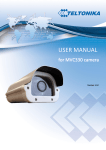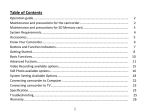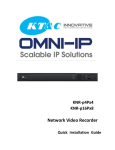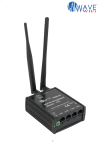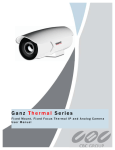Download USER MANUAL
Transcript
USER MANUAL Version 1.02 1 1. Legal notice Copyright © 2012 TELTONIKA Ltd. All rights reserved. Reproduction, transfer, distribution or storage of part or all of the contents in this document in any form without prior written permission of TELTONIKA Ltd is prohibited. The manufacturer reserves the right to modify the product and manual for the purpose of technical improvement without prior notice. Other product and company names mentioned herein may be trademarks or trade names of their respective owners. 2. Attention Before using the device we strongly recommend reading this user manual first. Do not rip open the device. Do not touch the device if the device block is broken. The device is not water-resistant. Keep it dry. Device is powered by a low voltage +12V DC power adaptor. 2 3. Table of Contents 1. Legal notice ................................................................................................................................................................ 2 2. Attention .................................................................................................................................................................... 2 3. Table of Contents ....................................................................................................................................................... 3 4. SAFETY INFORMATION............................................................................................................................................... 4 5. Introduction ............................................................................................................................................................... 5 6. Specifications ............................................................................................................................................................. 5 7. Setting up your camera.............................................................................................................................................. 6 8. 7.1. Camera overview ............................................................................................................................................... 6 7.2. Configuring your computer................................................................................................................................ 6 7.3. Installing VLAN player ........................................................................................................................................ 7 7.4. Connecting camera to PC................................................................................................................................... 8 7.5. Using camera in the car ..................................................................................................................................... 8 7.6. Using RTSP ......................................................................................................................................................... 9 Camera’s user interface ........................................................................................................................................... 10 8.1. Live view .......................................................................................................................................................... 10 8.2. Playback ........................................................................................................................................................... 11 8.3. Advanced settings ............................................................................................................................................ 11 8.3.1. Video settings .......................................................................................................................................... 11 8.3.2. Stream settings ........................................................................................................................................ 12 8.4. 9. Maintenance .................................................................................................................................................... 12 Abbreviations ........................................................................................................................................................... 14 3 4. SAFETY INFORMATION In this document you will be introduced on how to use a MVC300 camera safely. We suggest you to adhere to the following recommendations in order to avoid personal injuries and/or property damage. You have to be familiar with the safety requirements before using the device! To avoid burning and voltage caused traumas of the personnel working with the device please follow these safety requirements. The device is intended to be supplied from a Limited Power Source (LPS) whose power consumption should not exceed 15VA and current rating of overcurrent protective device should not exceed 2A. The highest transient overvoltage in the output (secondary circuit) of used PSU shall not exceed 71V peak. The device can be used with the Personal Computer (first safety class) or Notebook (second safety class). Associated equipment: PSU (power supply unit) (LPS) and personal computer (PC) shall comply with the requirements of standard EN 60950-1. Do not mount or service the device during a thunderstorm. To avoid mechanical damages to the device it is recommended to transport it packed in a damageproof pack. Protection in primary circuits of associated PC and PSU (LPS) against short circuits and earth faults of associated PC shall be provided as part of the building installation. To avoid mechanical damage to the device it is recommended to transport it packed in a damage-proof pack. While using the device, it should be placed so, that its indicating LEDs would be visible as they inform in which working mode the device is in and if it has any working problems. Protection against overcurrent, short circuiting and earth faults should be provided as a part of the building installation. 4 5. Introduction Thank you for purchasing a MVC300 camera! The MVC300 camera is a sleek and compact video recording device perfect for in-car mounting: an ideal solution if you want to capture any significant events that might occur on the road. It can also be used to augment any fleet management system with added video surveillance. With Ethernet functionality you can take the MVC300 camera out of the car altogether and integrate it into a stationary surveillance system, in other words it can perfectly double as a fully-fledged IP network camera. Video viewing also does not elude flexibility: it can be done via our Web Users Interface or through any video player capable of processing the RTSP streaming protocol. 6. Specifications Video 5Mpix CMOS sensor Sensor size: 1/2.5 inch H.264 compression Full HD 1080p @ 23 fps SXVGA (1280 x 960) @ 30 fps Functions 10/100Mbps Ethernet port microSD card slot (cards up to 32GB are supported) 8 x IR LEDs (for night version only) Light sensor (for night version only) Microphone Powered from DC connector or USB cable Embedded web server for live video and configuration Configurable RTSP stream Recording to microSD card Configurable recording length Configurable On Screen Display Windscreen mounting Electrical, Mechanical & Environmental: Dimensions (H x W x D) 67mm x 67mm x 45mm Weight 80g Power supply 12VDC car adapter or USB cable (5VDC) Power consumption < 3.5W Indicators 1 x status LED Operating temperature 0º to 45º C Storage temperature -20º to 60º C Operating humidity 10% to 90% Non-condensing Storage humidity 5% to 95% Non-condensing 5 7. Setting up your camera 7.1. Camera overview Front Panel 1 2 3 4 5 Back Panel Microphone Camera lens DC power connector IR LEDs (optional) Light sensor (optional) 1 2 3 4 5 microSD card slot USB/power connector Status LED Mounting connector Ethernet connector 7.2. Configuring your computer The camera can be connected to your computer via an ethernet cable. Camera‘s IP address is 192.168.1.10. Your PC has to be in the same subnet. 1. Go to Start > Control Panel > Network and Internet > Network and Sharing Center. In the left pane click Manage network connections link. Right click on Local Area Connection and select Properties. 6 2. Choose Internet Protocol Version 4 (TCP/IP) and click Properties. 3. Check if your PC‘s IP adress starts 192.168.1.x. If not, click Advanced... to bring up advanced setting. Click Add..., specify IP adress and Subnet mask (e.g. 192.168.1.1 and 255.255.255.0), click Add to save changes. 4. Click OK to apply new network settings. 7.3. Installing VLAN player VLAN player is necessary in order to be able to see video in the Live view window. If the player’s plugin is missing camera’s WebUI won’t show live video and may display a warning message: VLAN player installation steps: 1. Acquire VideoLAN player installer from www.videolan.org. 2. Launch downloaded installer. 7 3. Make sure both Mozilla plugin and ActiveX plugin are selected when choosing components. This will ensure that the plugin is installed on all browsers. 4. Complete VLAN player installation process. 7.4. Connecting camera to PC Camera can be connected to your PC for watching live video, playing back recorded files and changing settings. To connect the camera to your PC: 1. Insert microSD card. 2. Connect the camera to the PC with the USB cable in order to supply power to the device. 3. Connect Ethernet cable to the camera and PC (alternatively, you can connect both the camera and your PC to an Ethernet hub/switch). 7.5. Using camera in the car After setting the camera to the desired configuration it can be set up for use in the car: 1. 2. 3. 4. 5. Insert microSD card. Attach car mount to the camera. When in the car, attach camera to the windscreen. Connect car power supply adapter to camera’s DC power socket. Camera will start recording automatically after power is supplied. 8 7.6. Using RTSP Camera is capable of streaming video by RTSP protocol. After the camera is connected to the PC (or network) any RTSP capable media player can be used to see the video stream. To start an RTSP stream in VideoLAN player: 1. Go to Media and select Open Network Stream (alternatively Crtl +N combination can be used). 2. Enter URL rtsp://192.168.1.10:8557/PSIA/Streaming/channels/2?videoCodecType=H.264 and press Play to see stream video. 9 8. Camera’s user interface Camera’s WebUI can be accessed when camera is connected to your PC. Type http://192.168.1.10 into your internet browser’s address field in order to reach the camera’s WebUI. 8.1. Live view Live view tab displays video from the camera and is used to configure basic video settings. Resolution Specify video resolution of live stream and recorded videos. Possible options are: Audio HD: 720p 1280 x 720 D1: 480p 720 x 480 SXVGA 1280 x 960 Full HD: 1080p 1920 x 1080 When enabled live streaming and any recorded video will include audio. Video clip length Specify the length of the recorded video files. Video flip Select required video flip. Use the Both option if your camera is mounted upside down. OSD Check to include time and date information into video stream and recorded videos. Mode Select Day or Night mode to tune the camera to specific conditions. Save Press Save to apply new settings. 10 8.2. Playback In the Playback tab on the WebUI you can browse, download and delete recorded video files. Format To be able to use memory card it should be formatted as FAT32. The card can be formatted when inserted in your PC or by pressing Format when inserted in the camera. Amount to display Select number of files per page to display Delete selected Press to permanently delete selected files from camera’s SD card. 8.3. Advanced settings Advanced setting tab allows configurations of Video settings and Stream settings. 8.3.1. Video settings Brightness Specify brightness of the video. Allowed range is from 0 to 100. Contrast Specify contrast of the video. Allowed range is from 0 to 100. Saturation Specify saturation of the video. Allowed range is from 0 to 100. Sharpness Specify sharpness of the video. Allowed range is from 0 to 100. Backlight compensations Select desired backlight compensation or turn it off altogether. Flicker compensation When using the camera indoors, select correct flicker frequency to get a clean video. White balance Adjust white balance mode to achieve the best video quality in your conditions. 11 8.3.2. Stream settings Bit rate Increased bit rate results in better video quality while decreasing it allows for a smaller recorded file size. Rate control Rate control mode can to be constant (CBR), variable (VBR) or can be turned off. OSD Specify additional text to be displayed in the video and select its position. Image sensor mode Specify camera’s behaviour when data from video sensor contains more pixels than specified resolution. Pixels can be bound together, skipped or window mode can be used. 8.4. Maintenance Maintenance tab provides possibility to configure such settings as camera’s name, time, authorization and update device’s firmware. Camera name Specify the name of the camera. Name will be used in the file name of the recorded videos. Reset to defaults Press to reset camera’s configuration to default values. Restart Press to restart the camera. Time in camera Displays current camera’s date and time. Set time Specify desired date and time. Press Save at the bottom of the page to set the new values. Synchronize Press to synchronize camera’s date and time with your computer. 12 Authorization Check Enable if you want to use authorization when accessing camera’s WebUI. Password Type password to be used when authorizing. Username is always admin. Retype password Confirm previously typed password. Firmware version Displays current camera‘s firmware version Upgrade To upgrade camera‘s firmware press Upgrade buton to bring up firmware upgrade dialog described below. Browse Press Browse and select new firmware file. Send After firmware file is selected press Send to start firmware update process. 13 9. Abbreviations CBR Constant Bit Rate CMOS Complementary Metal–Oxide–Semiconductor FPS Frames Per Second HD High Definition Hz Hertz IP Internet Protocol IR Infrared Kbps Kilobits Per Second LED Light-Emitting Diode LPS Limited Power Source Mbps Megabits Per Second Mpix Mega pixel OSD On-Screen Display PC Personal Computer PSU Power Supply Unit RTSP Real Time Streaming Protocol SD Secure Digital SXVGA Super Extended Video Graphics Array USB Universal Serial Bus V Volts VBR Variable Bit Rate VDC Volts of Direct Current 14















